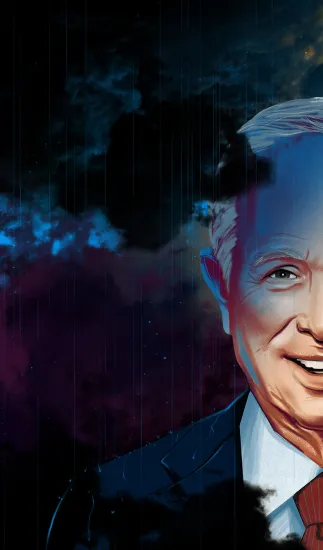
Stephen Schwarzman
(Illustration by Jonathan Bartlett)
The year was 1985. Schwarzman and Pete Peterson had left Shearson Lehman under strained circumstances to set up their own advisory business — the first step, they hoped, in building a private equity empire. The duo had boldly put an advertisement in The New York Times announcing the venture. But despite their renown — and they were already famous in the clique-y world of M&A — would anyone bite?
“How about some business?” I would ask.
“Not right now. But we’ll think about you in the future.”
The day after our advertisement appeared in the New York Times, I heard a knock at the door. I opened it to find a guy in leather pants, a black motorcycle jacket, and a little peaked leather motorcycle hat. We were waiting to hear from our familiar M&A clients, but we got the gang leader from The Wild Ones.
“Is there a Steve Schwarzman here?” he said.
“What are you delivering?”
“I’m not delivering anything. My name is Sam Zell. Leah told me I should meet you.” In 1979, we had hired Leah Zell at Lehman. She had been an English major at Harvard and had just gotten a PhD. After talking with her for a few minutes, it was obvious she had an exceptional mind. Though she knew nothing about finance, I had decided to give her a chance. She had proved to be a terrific analyst. This biker was her brother.
“What’s with the outfit?” I said.
“I left my motorcycle downstairs.”
“Where downstairs?”
“I chained it up on Park Avenue,” he said. “To a hydrant.” Our first day. This is some future, I thought.
He must have thought the same thing looking at me sitting there in my suit in our bare office, the phones silent.
“Look, I’m sorry. We just moved in today. We’ve hardly got any furniture yet.”
“That’s okay,” said Sam. He sat on the floor, leaned against the wall, against our rolled-up rug, and began to talk. He owned some real estate and wanted to buy some companies, but he didn’t know much about finance. “Why don’t you teach me?” he said.
I later found out that I shouldn’t have been misled by the outfit. Sam’s version of “owning some real estate” meant he was building one of the largest portfolios of real estate in the country. All he told me that day was he bought bankrupt properties and wanted to build an empire. We spent two and a half hours sitting on the floor talking. In the years to come, we would do a lot of business together. This one unexpected visitor turned out to be worth more to Blackstone than all the clients we expected in those early days who never came.
To coincide with our launch, the Wall Street Journal had planned to run a major front-page article about our new firm—publicity that would have been a huge boost for our new business. The day before it was supposed to run, the reporter called to tell me his editors were yanking it. He apologized. “The Shearson people heard we were doing it,” he said. “They called us up and said you were fired for a variety of bad reasons. We didn’t feel we could run the piece if Shearson told us on background that you’re a bad guy.”
I should have known our launch would rile Shearson. I had wanted out of Lehman because the ethics there had become so awful—the greed, the fear, the gutlessness, the hunger for power, the dishonesty. But this counterattack was a new low. I sat there in our bare office with boxes of office equipment scattered around. How could people be so vindictive?
Despite these setbacks, we were still confident enough to think that our reputations, our experience, and those hundreds of letters would bring in a flood of business. Weeks passed. Nothing. Pete had a secretary who was drawing a salary. I was making my own calls and taking deliveries at the front door. Every day I would look around the space we had rented. It felt like watching an hourglass, the money just draining out as the business never came. Not so long ago, people fought to have us work for them. Pete and I hadn’t changed, but now that we were out on our own, no one cared about us. As the days ticked by, I worried we would be just another failed start-up.
Finally, Squibb Beech-Nut, a pharma company we had worked with at Lehman, hired us for an advisory job for $50,000. In my previous life, that would have been less than the legal fees on a single deal. It was now a lifeline. Then another small job came in, from Armco, a medium-sized steel company in the Midwest and a client at Lehman. We were covering our rent and other basic costs, but we were still on the edge. By then it was the early summer [of] 1986, and we had been in business for nine months. Pete was away, my family was at the beach, and I was alone in Manhattan working on these two insignificant pieces of business.
One sweltering evening, I went for dinner alone to a Japanese restaurant on the second floor of a building on Lexington Avenue in the thirties. As I was sitting there, I began to feel dizzy, as if my whole body wanted to collapse. I felt I was failing on every count. I was overwhelmed by self-pity. Wall Street loves nothing more than watching other people fail. To see Pete and me, who had been so powerful at Lehman, so sure of our success, take a beating would have given many people pleasure. I couldn’t let it happen. I could not fail. I had to find a way.
Shortly after my lonely Japanese dinner, Hays Watkins, the chief executive of CSX, a large railroad company, called us. In 1978, I had overseen the sale of a newspaper company that CSX owned. The standard sale would have involved an English auction—the kind you see in auction houses where the bidders raise their hands, increasing their offers incrementally, until the second-highest bidder drops out. All you have to do to win is bid a dollar more than the next bidder. The problem with these auctions is that you never know what the winner might have been willing to pay. Someone might buy a Van Gogh painting for $50 million, but perhaps if there had been another bidder, the buyer could have been pushed up to $75 million.
For CSX’s newspapers, I had staged a two-round sealed-bid auction. In each round, the bidders submitted their bids in a sealed envelope, not knowing what others were offering. The first round weeded out the low bids, the people just fishing. The serious buyers then got to review the target company’s financials and visit with management. After that they submitted another sealed bid. The magic of this kind of auction is that if the buyers are desperate to acquire the asset, they won’t just try to offer a dollar more than the second-highest bidder. They will offer the highest price they can afford to ensure they win. This style of auction was little known in the M&A world when I began doing it, but it has since become standard practice. Watkins said he remembered me as an innovator and problem solver.
“We have a project,” Watkins said. “We’re just starting on it. We thought maybe you could work on it.” Maybe we could work on it? We were sitting around worrying about going broke. But I knew that he wouldn’t have come to us if the situation were simple. There were lots of advisers who could help. Watkins had a difficult problem, and he wanted an inventive solution. As an investment banker and later as an investor, I found that the harder the problem, the more limited the competition. If something’s easy, there will always be plenty of people willing to help solve it. But find a real mess, and there is no one around. If you can clean it up, you will find yourself in rare company. People with tough problems will seek you out and pay you handsomely to solve them. You will earn a reputation for doing what others cannot. For a pair of entrepreneurs trying to break through, solving hard problems was going to be the best way of proving ourselves.
CSX wanted to expand into ocean shipping and had made a friendly and generous offer to buy Sea-Land Corporation, a container company. The management of Sea-Land was keen to accept it, but they were being held up by Harold Simmons, a crusty Texan investor. Simmons had no interest in owning Sea-Land. But he had been buying stock in anticipation of an outside acquisition, intending to hold up any sale until he got the price he wanted. He wanted to be overpaid to go away. The finance industry calls this practice “greenmail.”
CSX’s initial offer was a reasonable $655 million. At Lehman, I’d have had a whole team to support me on a deal this size. Now I had to handle this work alone. Simmons owned 39 percent of the stock in Sea-Land. We couldn’t force him to sell, but at the price CSX was offering, Simmons would have made a handsome profit. Still, he was in a strong position to hold out for more. I spoke to him on the phone, explaining how much he stood to make based on the current offer. I can still hear his Texan accent: “Mr. Schwarzman, Ah’ve told you many times already, Ah am not selling my shares. Ah am not!” I tried everything to persuade him, until I decided to fly down to see him with our attorney.
Simmons was thin, lanky, with a pock-marked face. He was in his mid-fifties but looked much older. His office gave no hint of his considerable wealth. It was in a cheap building outside Houston, the interior walls covered with peeling wood veneer.
“We’d really like to buy this business, and you’re sort of getting in the way,” I said. “We’d like you to move aside. We’d like to buy your stock. As you know, we’re offering a premium.”
“Ah know what you want,” he said. “Ah’ve told you, mah stock is not for sale.”
“I thought you were going to say that,” I said. “So I’ve prepared a special arrangement I’m making available for stockholders who don’t want to participate in our tender offer.” He was the only one. “If you don’t want the cash, I’m going to substitute a private issue, PIK [payment in kind, i.e., not cash] preferred stock with no maturity date.”
What this proposal meant was that he could either take the cash, or we were going to turn his asset into a serious liability. If he wanted to take CSX hostage, I was going to do the same to him by using the tender offer to force a merger and freeze him out. His preferred stock wouldn’t be listed on any exchange, so he wouldn’t be able to sell it easily. It would also be junior to corporate debt in the capital structure, so if anything went wrong, he wouldn’t get paid until after the creditors. And with no maturity date, he would never even have a chance to redeem his stock because it would never come due. He would just be stuck holding stock that generated ever-increasing tax bills for the indefinite future. The proposition was detestable and highly unusual.
Simmons looked at me, then looked at his lawyer. “They can do this?” Simmons asked.
“Mmmh hmm,” the lawyer said, bobbing his head up and down. “They can do it.”
Simmons turned to me. “Get the hell out of my conference room!” My attorney and I walked out, got into the car, and drove back to the airport. From the pay phone in the lounge, I called my secretary. Simmons had just called to tell me he’d be selling his stock.
If the job had been easy, we would never have gotten it. It required creativity and psychological insight to identify Simmons’s weakness and nerve to confront him with our solution to CSX’s problem. This assignment was a breakthrough for us. It was the first major fee we received for our advisory business, and it made Blackstone’s name as an M&A shop.
After we wrapped it up, Hays told me he was bringing in Salomon Brothers for a fairness opinion on the price they had paid. I had written dozens of fairness opinions at Lehman since my first assignment for Herman Kahn. I told Hays he didn’t need Salomon. We could do it for him. I knew Sea-Land and CSX, having just done the deal. Hays agreed. I even waived the fee. Blackstone became the first major boutique advisory firm to write a fairness opinion.
I thought we should raise a billion dollars for our first fund, which would make it by far the biggest first-time fund ever launched. Pete thought I was dreaming.
“We’ve never done a single private equity deal,” he said. “And neither of us has ever raised any investment money for ourselves.”
“So what?” I said. “I know the guys who do this stuff. I represented them at Lehman. I’ve been in the room.” If they could do it, I assured Pete, we could.
“It doesn’t trouble you that we haven’t done a deal yet?”
“No, it doesn’t.”
“It does me,” said Pete. “I think we should start with a $50 million fund, learn what we’re doing, and then do something bigger.”
I told Pete I disagreed for two reasons. First, when investors put money in a fund, they want to know that theirs isn’t the only money. So if you’re raising a $50 million fund, chances are you’ll have to raise it in increments of $5 to $10 million. And if you’re going to all the bother of raising $5 to $10 million, you may as well save yourself some legwork and ask for $50 to $100 million. Second, investors would expect us to build a diversified portfolio. With only $50 million in hand, we’d have to do a series of tiny deals to get there. Since our expertise was in working with big corporations, tiny deals made no sense.
Pete was still apprehensive. “Why would somebody give us money when we’ve never done anything?” he asked.
“Because it’s us. And because it’s a moment.”
When I began my career, I was like most other ambitious young people: I believed success was achieved in a straight line. As a baby boomer, I had grown up seeing only growth and opportunity. Success seemed a given. But working through the economic ups and downs of the 1970s and early 1980s, I had come to understand that success is about taking advantage of those rare moments of opportunity that you can’t predict but come to you provided you’re alert and open to major changes.
Demand for LBO deals was rising among investors, but the supply was limited and the people who could execute them even more so. It was the perfect scenario for a pair of entrepreneurs with our particular skills. Years earlier at Lehman, we couldn’t get the bank’s executive committee interested in LBOs. We were ahead of their conventional thinking. Now, if we waited any longer, we risked being too late. Others would attract the eager money looking for ways into buyout deals.
“I’m convinced that now is the right moment for us to raise a fund and that moment may never reappear for us,” I told Pete. “We’ve got to hit it.”
As a salesman, I’d learned you can’t just pitch once and be done. Just because you believe in something doesn’t guarantee anyone else will. You’ve got to sell your vision over and over again. Most people don’t like change, and you have to overwhelm them with your argument, and some charm. If you believe in what you’re selling and they say no, you have to presume that they don’t fully understand, so you give them another opportunity. After many discussions, Pete, in his own way, gave in.
“If you feel that strongly, I’ll sign on for it.”
Sign up for the Essential II newsletter to ensure you are notified when we publish the second installment of What It Takes, which details the travails Schwarzman and Peterson faced in transitioning their burgeoning M&A business into a private equity powerhouse.
You can buy What It Takes here.





